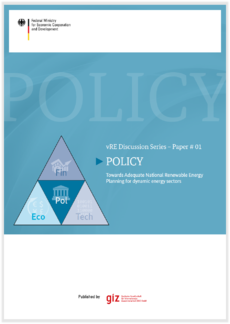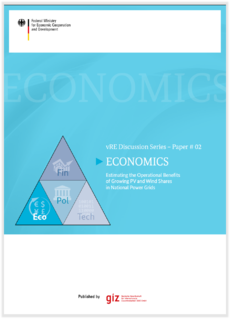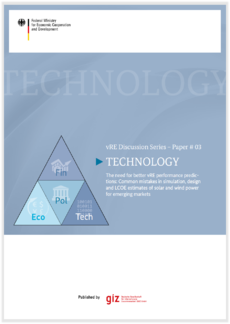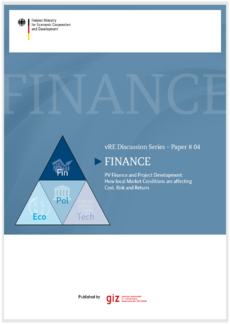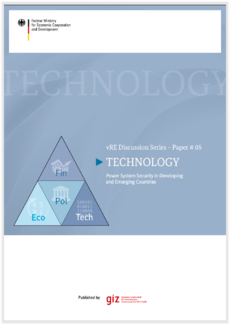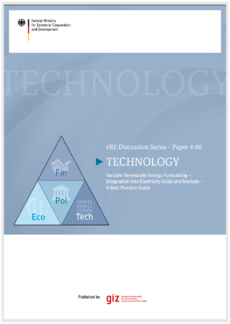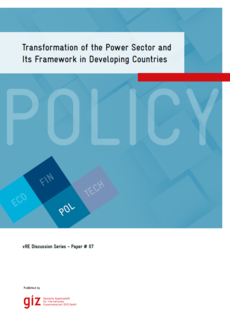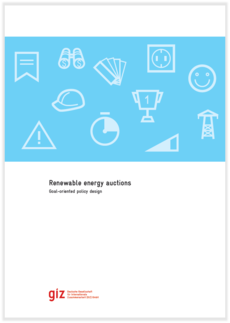Knowledge fuels change
For over a decade, Energypedia has shared free, reliable energy expertise with the world.
We’re now facing a serious funding gap.
Help keep this platform alive — your donation, big or small, truly matters!
Thank you for your support
Difference between revisions of "VRE Discussion Series"
***** (***** | *****) |
***** (***** | *****) m |
||
| (One intermediate revision by one other user not shown) | |||
| Line 1: | Line 1: | ||
| − | |||
{| style="width: 783px" cellspacing="0" cellpadding="0" border="0" | {| style="width: 783px" cellspacing="0" cellpadding="0" border="0" | ||
|- | |- | ||
| Line 34: | Line 33: | ||
<br/> | <br/> | ||
| − | = Published Discussion Papers | + | = Published Discussion Papers = |
| − | == Paper 1 – Policy | + | == Paper 1 – Policy == |
{| style="width: 737.08px" cellspacing="1" cellpadding="0" border="0" | {| style="width: 737.08px" cellspacing="1" cellpadding="0" border="0" | ||
| Line 48: | Line 47: | ||
|} | |} | ||
| − | == Paper 2 – Economics | + | == Paper 2 – Economics == |
{| style="width: 737.08px" cellspacing="1" cellpadding="0" border="0" | {| style="width: 737.08px" cellspacing="1" cellpadding="0" border="0" | ||
| Line 62: | Line 61: | ||
|} | |} | ||
| − | == Paper 3 – Technology | + | == Paper 3 – Technology == |
{| style="width: 737.08px" cellspacing="1" cellpadding="0" border="0" | {| style="width: 737.08px" cellspacing="1" cellpadding="0" border="0" | ||
| Line 74: | Line 73: | ||
|} | |} | ||
| − | == Paper 4 – Finance | + | == Paper 4 – Finance == |
{| style="width: 737.08px" cellspacing="1" cellpadding="0" border="0" | {| style="width: 737.08px" cellspacing="1" cellpadding="0" border="0" | ||
| Line 86: | Line 85: | ||
|} | |} | ||
| − | == Paper 5 – Technology | + | == Paper 5 – Technology == |
{| style="width: 737.08px" cellspacing="1" cellpadding="0" border="0" | {| style="width: 737.08px" cellspacing="1" cellpadding="0" border="0" | ||
| Line 100: | Line 99: | ||
<br/> | <br/> | ||
| − | == Paper 6 – Technology | + | == Paper 6 – Technology == |
{| style="width: 737.08px" cellspacing="1" cellpadding="0" border="0" | {| style="width: 737.08px" cellspacing="1" cellpadding="0" border="0" | ||
| Line 114: | Line 113: | ||
<br/> | <br/> | ||
| − | == Paper 7 – Policy | + | == Paper 7 – Policy == |
{| cellspacing="1" cellpadding="0" border="0" | {| cellspacing="1" cellpadding="0" border="0" | ||
| Line 132: | Line 131: | ||
<br/> | <br/> | ||
| − | = Featured Publications | + | = Featured Publications = |
{| style="width: 737.08px" cellspacing="1" cellpadding="0" border="0" | {| style="width: 737.08px" cellspacing="1" cellpadding="0" border="0" | ||
| Line 146: | Line 145: | ||
<br/> | <br/> | ||
| + | [[Category:Energy_Efficiency]] | ||
| + | [[Category:Policies_and_Regulations]] | ||
| + | [[Category:Energy_Access]] | ||
| + | [[Category:Renewable_Energy]] | ||
[[Category:Financing_and_Funding]] | [[Category:Financing_and_Funding]] | ||
| − | |||
| − | |||
| − | |||
| − | |||
| − | |||
Latest revision as of 08:14, 12 September 2022
|
Under the ‘vRE Discussion Series’, we put forth emerging results and issues of special interest to GIZ partners, along the main fields of our work: vRE policy, economics, finance and technology issues. As the series’ title indicates, these are often based on work in progress, and we strongly encourage suggestions and ideas by mail to the contact below. Jens Burgtorf - Head of Sector Program "Technology Cooperation in the Energy Sector": jens.burgtorf@giz.de Elmar Schuppe - Sector Program "Technology Cooperation in the Energy Sector": elmar.schuppe@giz.de |
The vRE Discussion Series includes the following publications:
- Paper 1 – Policy: Towards Adequate National Renewable Energy Planning for dynamic energy sectors
- Paper 2 – Economics: Estimating the Operational Benefits of Growing PV and Wind Shares in National Power Grids
- Paper 3 – Technology:The Need for better vRE performance predictions: Common mistakes in simulation, design and LCOE estimates of solar and wind power for emerging markets
- Paper 4 – Finance: PV Finance and Project Development; How local Market Conditions are affecting Cost, Risk and Return
- Paper 5 – Technology: Power System Security in Developing and Emerging Countries
- Paper 6 – Technology: Variable Renewable Energy Forecasting - Integration into Electricity Grids and Makets - A Best Practice Guide
- Paper 7 – Policy: Transformation of the Power Sector and Its Framework in Developing Countries
The GIZ TechCoop vRE Programme
Over the past decade, a ‘1st wave’ of National Subsidy Programmes for variable (i.e. fluctuating) Renewable Energies (vRE) has (i) led to impressive growth in global cumulative installed capacity of wind and PV power and (ii) dramatic RE cost reductions. However, due to their typical ‘technology push’ focus, most of these 1st wave national vRE programmes have not aimed at achieving an economically optimal pathway for national wind and PV development over time. Naturally, this has led to suboptimal national RE deployment, resulting in (i) unnecessary losses of Government budget and credibility (subsidy schemes were too expensive or too slow, RE technologies were scaled up too early or applied at the wrong network nodes, lack of planning resulted in avoidable transmission losses or dispatch problems), and/or (ii) excessive private sector profits and/or massive insolvency waves after subsidy-driven vRE bubbles. None of this is intrinsic to vRE technologies or economics: it was simply ill-advised planning.
Increasingly, OECD and non-OECD governments want to move beyond simple vRE technology-push policies, and shift to a new, 2nd wave of optimised national vRE pathways, by applying the same fundamental economic, financial, and political target functions that are used successfully for standard power system planning. To this end, vRE need to be analysed as an integral part of the national energy system and its growth in time and space, by applying methods which readily fit the toolkit already used by dispatchers, regulators, and utilities.
vRE integration has advanced in numerous power sectors and these have experienced a steep learning curve with respect to changes in system operations and expansion, business models and planning, policies and institutions, and further transformation will require more innovative approaches. At the same time, some global trends such as rapid innovation deployment, policy, and finance are and will be changing the power sector profoundly and in every aspect, all over the world. This requires advanced adjustment, in some cases even a disruptive change in respective planning, policy, business models, and institutional framework. Institutional response, however, is discussed so far mostly for industrialised countries, but indeed only for very few emerging economies. Therefore, the GIZ Technology Cooperation vRE Programme is compiling solutions and transmitting them to developing countries, which face the challenge of change sooner or later.
Published Discussion Papers
Paper 1 – Policy
|
|
Paper 1 – Policy: Towards Adequate National Renewable Energy Planning for dynamic energy sectors |
Paper 2 – Economics
|
|
Paper 2 – Economics: Estimating the Operational Benefits of Growing PV and Wind Shares in National Power Grids
|
Paper 3 – Technology
|
|
Paper 3 – Technology: The Need for better vRE performance predictions: Common mistakes in simulation, design and LCOE estimates of solar and wind power for emerging markets |
Paper 4 – Finance
|
|
Paper 4 – Finance: PV Finance and Project Development; How local Market Conditions are affecting Cost, Risk and Return |
Paper 5 – Technology
|
|
Paper 5 – Technology: Power System Security in Developing and Emerging Countries |
Paper 6 – Technology
|
|
Paper 6 – Technology: Variable Renewable Energy Forecasting - Integration into Electricity Grids and Makets - A Best Practice Guide |
Paper 7 – Policy
|
|
Paper 7 – Policy: Transformation of the Power Sector and Its Framework in Developing Countries
|
Featured Publications
|
|
Titel: Renewable Energy Auctions - Goal-oriented policy design |


